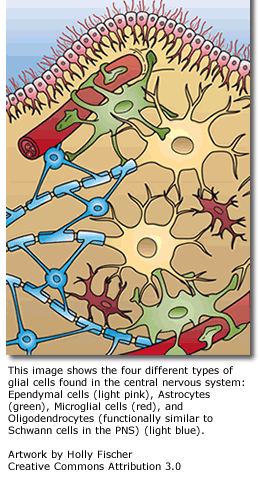HIV in the CNS
 Evidence of HIV RNA in the CNS may be detectable in humans as early as eight days after exposure (Valcour. 2012). CNS inflammation is apparent by cerebral spinal fluid analysis in some individuals during acute HIV infection. The virus is believed to cross the blood-brain barrier in infected phagocytic monocytes using a Trojan-Horse mechanism (Evans 2020).
Evidence of HIV RNA in the CNS may be detectable in humans as early as eight days after exposure (Valcour. 2012). CNS inflammation is apparent by cerebral spinal fluid analysis in some individuals during acute HIV infection. The virus is believed to cross the blood-brain barrier in infected phagocytic monocytes using a Trojan-Horse mechanism (Evans 2020).
When an infected monocyte enters the CNS, it disperses HIV, infecting microglia, astrocytes, other macrophages (Williams 2014). Unfortunately, the blood-brain barrier limits the passage of many antiretroviral medications into the CNS. This results in a sequestered source of HIV that can be covertly replicating even when HIV RNA in the blood is undetectable.
HIV infection increases the risk of central nervous system (CNS) complications:
- HIV Associated Neurocognitive Disorders (HAND) - The incidence of HIV associated dementia (HAD) has declined since the introduction of antiretroviral medications. HAD is now more common with age and advanced HIV/AIDS. However, less disabling HAND conditions including: mild neurocognitive disorder (MND) and asymptomatic neurocognitive impairment (ANI) commonly decrease the quality of life for HIV+ persons, despite adhering to antiretroviral treatment.
- Viral infections of the CNS - Cytomeglovirus, varicella zoster virus, John Cunningham virus are more common in advanced HIV/AIDS.
- Fungal and parasitic infections - Cryptococcal neoformans fungus and toxoplasma encephalitis are more common in the immunosuppressed.
- Lymphomas - "Lymphomas are perhaps the cancer type that is most closely associated with oncogenic viruses: infection with EBV, human T-lymphotropic virus 1 (HTLV-1), human immunodeficiency virus (HIV), Kaposi sarcoma-associated herpesvirus/human herpesvirus 8, and hepatitis C virus have all been associated with lymphomagenesis" (Esau D. 2017).
Neuropathology:
HIV is known to affect a number of CNS cell types:
- Microglia - are mobile macrophages of the CNS. They use phagocytosis and cytotoxic mechanisms to eliminate pathogens and debris. Microglia are proinflammatory. They are also the primary site for HIV replication within the CNS.
- Astrocytes are another type of glial cell. Astrocytes provide support and sustenance for the blood brain barrier and neurons.
- CNS neurons - Neurons are not an important source of HIV replication but exposure to transactivator of transcription (Tat) protein shed by HIV infected cells has been shown to induce neurotoxicity in cultured mouse neurons reducing the length and number of dendrites and impairing neuron metabolism. These mechanisms together could impair cognition (Liu 2018)
HIV entry into the CNS results in the activation of astrocyte, monocyte, and microglial inflammatory response that cause neuronal dysfunction and cognitive impairment. Imaging studies may show atrophy of subcortical structures and reduced cortical thickness. Similar findings have been obtained with measurements of the lateral ventricles, corpus callosum, caudate nucleus, and hippocampus (Valcour 2011).
The usual symptoms that reflect damage to the structures of the brain, especially the basal ganglia, thalamus, and brainstem, include: difficulties with attention, concentration, information processing speed and response time, memory, verbal fluency, visuospatial and visuoconstructive capacity, and abstract reasoning. There may be significant personality changes, irritability, social withdrawal, and emotional lability. Patients may have signs similar to those of Parkinson's disease, including bradykinesia, tremor, and gait disturbance, and may have increased reflexes on neurological examination (Brosch 2018).
References
Ajasin D., & Eugenin, E. A. (2020). HIV-1 Tat: Role in Bystander Toxicity. Frontiers in cellular and infection microbiology, 10, 61. https://doi.org/10.3389/fcimb.2020.00061
Brosch J.R. (2018) Human Immunodeficiency Virus-Associated Neurocognitive Disorder.
Reference Module in Neuroscience and Biobehavioral Psychology. Retrieved 5/10/2021 from
https://www.sciencedirect.com/topics/medicine-and-dentistry/hiv-associated-neurocognitive-disorder
Esau D. (2017). Viral Causes of Lymphoma: The History of Epstein-Barr Virus and Human T-Lymphotropic Virus 1. Virology : research and treatment, 8, 1178122X17731772. https://doi.org/10.1177/1178122X17731772
Evans T. (2020) How Pathogens Penetrate the Blood-Brain Barrier. American Society for Microbiology. Retrieved 5/10/2021 from
https://asm.org/Articles/2020/April/How-Pathogens-Penetrate-the-Blood-Brain-Barrier
Kim, K. S. (2014). How Pathogens Penetrate the Blood-Brain Barrier. Microbe Magazine, 9(12), 487–492. https://doi.org/10.1128/microbe.9.487.1
Liu, Y., Zhou, D., Feng, J., Liu, Z., Hu, Y., Liu, C., & Kong, X. (2018). HIV-1 Protein Tat1-72 Impairs Neuronal Dendrites via Activation of PP1 and Regulation of the CREB/BDNF Pathway. Virologica Sinica, 33(3), 261–269. https://doi.org/10.1007/s12250-018-0031-4
Valcour, V., Chalermchai, T., Sailasuta, N., Marovich, M., Lerdlum, S., Suttichom, D., Suwanwela, N. C., Jagodzinski, L., Michael, N., Spudich, S., van Griensven, F., de Souza, M., Kim, J., Ananworanich, J., & RV254/SEARCH 010 Study Group (2012). Central nervous system viral invasion and inflammation during acute HIV infection. The Journal of infectious diseases, 206(2), 275–282.
Valcour, V., Sithinamsuwan, P., Letendre, S., &; Ances, B. (2011, March). Pathogenesis of HIV in the central nervous system. Current HIV/AIDS reports. https://www.ncbi.nlm.nih.gov/pmc/articles/PMC3035797
Williams, D. W., Veenstra, M., Gaskill, P. J., Morgello, S., Calderon, T. M., & Berman, J. W. (2014). Monocytes mediate HIV neuropathogenesis: mechanisms that contribute to HIV associated neurocognitive disorders. Current HIV research, 12(2), 85–96. https://doi.org/10.2174/1570162x12666140526114526
 Evidence of HIV RNA in the CNS may be detectable in humans as early as eight days after exposure (Valcour. 2012). CNS inflammation is apparent by cerebral spinal fluid analysis in some individuals during acute HIV infection. The virus is believed to cross the blood-brain barrier in infected phagocytic monocytes using a Trojan-Horse mechanism (Evans 2020).
Evidence of HIV RNA in the CNS may be detectable in humans as early as eight days after exposure (Valcour. 2012). CNS inflammation is apparent by cerebral spinal fluid analysis in some individuals during acute HIV infection. The virus is believed to cross the blood-brain barrier in infected phagocytic monocytes using a Trojan-Horse mechanism (Evans 2020).